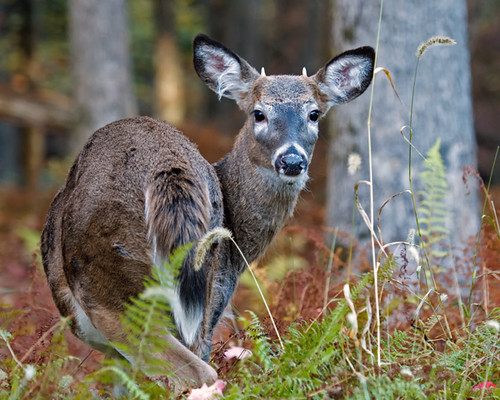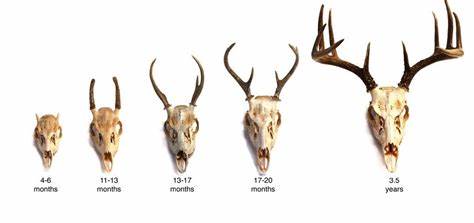29 Apr BONING UP!!!
Antlers are bone! They are not horn, which is a modified hair cell. Since antlers are shed annually, they need to regrow each season. Now is when that antler growth is crucial.

Bones on deer heads begin at the Pedicle! This bump is found on the buck’s foreheads. Antlers grow up from the Pedicle and detach at the same point. Proper pedicle development will determine quality antlers. Pedicles develop after birth and take about 4-5 months to show up. Once the young buck begins to produce testosterone, and gain appropriate weight, the bony protrusions, antlers, will begin to grow.
Young bucks can determine the health of a deer population. Body growth supports the growth of the pedicle, and later the antlers.

Mature bucks drop, or shed, their antlers at the end of winter. New antlers immediately begin to form. It was once thought that the bucks shed antlers because they became too heavy and broke off. In fact, the blood flow ceased, and the antler bases eventually pull free. A tinge of blood is common on the pedicle and antler bases.
DNA is a big part of bucks with big antlers. The racks grow in mass and size until about 6-7 years of age. Then the antlers begin to grow smaller. If proper food and health are consistent, the Buck will add tines and thickness to what becomes a great rack.
Bucks with young, small antlers, or spikes, were once thought to be inferior. These bucks were targeted as cull deer. It turns out that a buck with spikes inn their first season can become great branched bucks as they mature. Button bucks are often late born fawns. Bucks that are healthy will produce their first polished antler by 6-7 months of age. One reason for this is the immature pedicle. As the pedicle increases in size, so will the antlers. It is not uncommon for spikes to mature late in December and be shed in February.
When the blood flow stops nourishing the velvet and antler, the velvet will fall off. This is when the buck polishes their antlers. There is no itching or pain since bone, antler, have no nerves in it. When bucks rub on trees, they are shining up their headgear to attract does. The velvet is often eaten by the young deer or other deer in the herd. Does also eat the afterbirth. These are the only times when deer may be considered an omnivore.
Spike antlers that are smooth and consistent in size and shape are a trait of healthy bucks. If a bur, uneven length, or other irregularity shows up, it shows the buck has undergone trauma or is unhealthy. Spikes less than 3 inches long are a sign of less maturity and a later drop fawn. Late season velvet covered bucks are in this category. Since most fawns are born in late April and May, they are often enjoying a food filled Spring. This begins the healthy nutrition for these future bucks.
Yearling bucks can have branched antlers. Forks, 3×3, or even small 4×4 racks can occur when weather, genetics, nutrition, and quality of life all fall into place. Bucks living around ideal food crops, agriculture, or food plots can fall into this category. True trophy racks happen for just a few seasons.
When fawns are born really late, they may show no noticeable antlers. These button bucks are often harvested during antlerless deer seasons. Bucks can be born in August and September if a late previous Rut occurred. These deer will also have a harder time surviving the Winter. Nutrition decreases as the Fall becomes Winter. If these bucks do survive, the next season can get back on track for more normal antler growth.
The photoperiod determines when bucks shed, Rut, and go into reproduction mode. Day length is critical as the clock to determine healthy cycles. The longer the days, the more plants can grow. The more plants, the more available food and cover.
Stress is also a determining factor for antler growth. Areas with more predators means that the deer are chased, or under constant stress. Suburban areas or places near railroads or traffic means more car strikes and mortality. Social stress also is at issue. When bucks compete for which Does, that they want to mate with, injury, broken antlers, and stress are a problem. In extreme battles, antlers may lock up or end in death. Young spike bucks are willing but bigger bucks will often horn in on the action. The goal is for Does to mate with the strongest and the fittest. It is not uncommon for does to mate with several bucks. Spike bucks can fall into this group even if their DNA does not add to the gene pool. At least they learn what to do. The DNA from a healthy spike buck could be of high quality to produce future trophy bucks.
Mature Does ultimately produce each year’s best quality bucks. Since they are dominant and familiar with the habitat, they know where the best food, cover, and survival areas are. They also tend to breed with only the better and bigger bucks.
The overall population of an area also will impact antler growth. More deer means more competition for food, bedding, reproduction, and quality living space. Fortunately, these areas also are the homes of predators like coyotes, wolves, lions, and regional predators. Disease also shows up in areas with bigger, more crowded populations. Thinning the herd assures survival of the stronger and healthier critters. As the deer herd changes in population size, so will the predator base.
Like most things in life, “The One Thing” is that there is “Never just One Thing!”. Annual buck antler size is a symptom of a healthy or stressed deer herd. Even in a trophy deer management area, harvests of big antlers changes with the weather and other conditions. Therefore, when a hunter harvests a really great buck, it may be their buck of a lifetime.
Enjoy the Big Boned Bucks when you can!
Montana Grant
For more Montana Grant, find him loving deer at www.montanagrantfishing.com.

